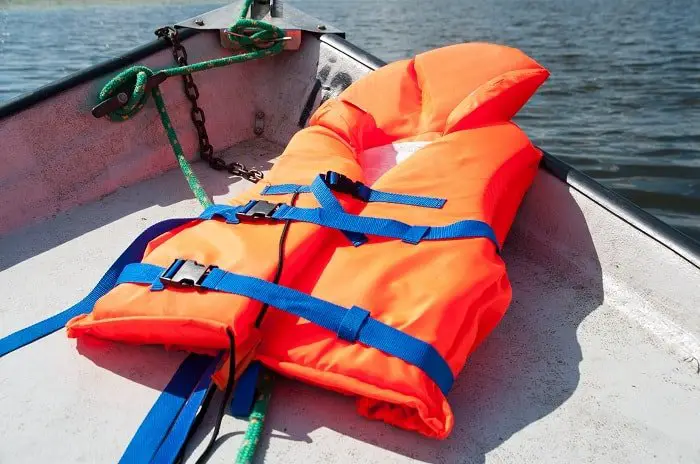Last Updated on July 7, 2022 by Ecorf
The Personal Flotation Device (PFD) is one of the security measures that are peculiar to paddlers and kayakers. With the designation as safety equipment, PFDs have, over the years, grown to become one of the most used security apparatuses for keeping the wearer afloat on the water, especially in the event of a mishap or capsizing of the vessel.
There are many angles to the use of the Personal Flotation Device (PFD). Aside from storing the equipment in a suitable environment, you also have to consider the possibilities of wear and tear on the fabric.
Table of Contents
How Do You Fix A Tear in the Outer Fabric of A PFD?
Worthy of mention is that the chances of the PFD from tearing are higher when you don’t exercise care in storing it. Personal Flotation Device (PFD) owners ought to be careful about how they store the device. In the light that the equipment got torn by some chances, then what are the options you have to fix it?
Highlighted below are some of the feasible ways to fix a tear in the outer fabric of your Personal Flotation Device (PFD).
-
Iron On A Patch
Patchwork could be the solution you need to fix your torn PFD in real-time. For many paddlers, this option is not only faster, but comes with other advantages, such as reduction of costs, and the immediacy of fixing the torn part. You should note that some factors need to be considered before considering patching the PFD.
The first is that the patching should be considered if the tea on the PFD is not rooted. Hence, if the tear is not deep enough to cut through the device, then patching it could be a way to fix it in a good time. While at it, ensure that you hand over the patching job to a professional. Also, the patching should be done in a way that it does not only hide the tear but does not affect the performance of the device.
On the flip side, patching the Personal Flotation Device (PFD) comes with some challenges. The first is that repairing the device could give way to more tears, especially when it is not done in the right direction. In such an instance, the PFD tends to be unreliable, because it can tear the more without notice.
-
Repair the PFD with Duct Tape
If repairs are still your thing, then you may consider repairing the device with the duct tape. Also, care should be exercised in this instance, so that you don’t end up causing more tears on the device.
-
Replace the PFD
The last but not the least is to replace the Personal Flotation Device (PFD). Many paddlers and PFD owners are more pleased to use this option because it is a viable way to prevent further tears on the device.
The need for replacement is not unconnected to the potential anomalies that might arise from the continuous use or repairing of the device. Changing the PFD is also advised because the device might cause accidents when worn in the water or start malfunctioning after it gets torn.
So, if you’re financially buoyant, you should consider replacing your Personal Flotation Device (PFD) as a way to increase your chances of stability when using it.
How To Discover Tears on A PFD
Is it possible to spot the tears without hassles? If so, what are the ways you can do that? The tips below are helpful.
-
Large Tears or Rips
In some cases, you would discover that the tears are visible. Large openings or rips denote those. Take a cue from those and either change the device or repair it, if possible.
-
Oil Spills
Do you notice oil spills on your Personal Flotation Device (PFD)? That is a clue that the device is about to lose much of its buoyancy. The last thing you would want is to be frustrated when you need the PFD to keep afloat. So, take note of the oil spills when sighted and take steps to change the device.
-
Damaged or Broken Hardware
Broken hardware is equal to a torn PFD. So, if the hardware on the device is damaged or broken, it’s time to change or repair it.
-
Torn, Ripped, or Missing Webbing
The webbing of the Personal Flotation Device (PFD) might be ripped, missing, or torn. If that is the case, you should consider changing or replacing it.
-
Rotten Material
Rotten material is another factor that hints on the possible tear on a Personal Flotation Device (PFD).
Precautions to Keep Your PFD Safe from Damage
It’s one thing to discover the tears on your Personal Flotation Device (PFD). It’s another to take steps to prevent future occurrences. Below are some of the precautions you need to take to keep your PFD safe from damage.
-
Don’t Place Under Direct Sunlight
Sunlight doesn’t tag along with Personal Flotation Devices (PFDs). Placing the device under direct sunlight exposes it to the UV rays, which, in turn, have adverse effects on the quality of the equipment.
-
Store in A Cool, Dry Area
If the PFD cannot be stored in a place under direct sunlight, then the perfect thing is to store it in a cool place. The rule of thumb is to save the device in an area that is cool and not prone to the adverse effects of sunlight.
-
Hang the Personal Flotation Device
Many PFD owners tend to store it on a shelf or place it on the floor. You should stop that if it is the case. Instead, hang the device where it tends to stay higher.
-
Store in A Ventilated Area
The last but not the least is to store the Personal Flotation Device (PFD) in a non-ventilated place.
To reduce the chances of tears and rips, you should store the device in a place or room that has enough ventilation. Such a move ensures that the Personal Flotation Device (PFD) wouldn’t be prone to the rotting of hardware and other parts.
Fix the Tear in the Outer Fabric of Your PFD
By following the tips mentioned above, you wouldn’t have a hard time fixing the tear in the outer fabric of your Personal Flotation Device (PFD). So, use them and set your torn PFD in good time.


